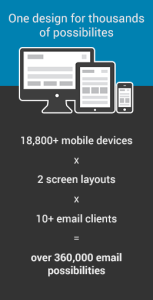The viewing combinations for email are endless. If you multiply the number of screen sizes on all the desktop and mobile devices times the number of email client services and then factor in the ability to read content horizontally and vertically, you end up with hundreds of thousands of email possibilities. It is seemingly an impossible task to design one email to fit all sizes and shapes. Which is why many of today’s designers feel much like the cryptographers in the movie “The Imitation Game.”
 The movie follows the real-life story of legendary cryptanalyst Alan Turing. It tells the story of how Turing and his brilliant team of code-breakers had to devise a way to decipher Nazi encrypted messages within 24 hours. The team is credited with providing the intel the Allies needed to win. Historians say Turing saved millions of lives and shortened the war.
The movie follows the real-life story of legendary cryptanalyst Alan Turing. It tells the story of how Turing and his brilliant team of code-breakers had to devise a way to decipher Nazi encrypted messages within 24 hours. The team is credited with providing the intel the Allies needed to win. Historians say Turing saved millions of lives and shortened the war.
Following Turing’s logic for email marketing will not save millions of lives, but it may save millions of emails from going straight to the trash. The goal of most emails is to get the person to click on a link and perform a task or take an action. Mobile users are a different breed of people — they are 5 times more likely to abandon a task if a message is not fully mobile optimized.
Here is how you can use Turing’s approach to crack the email marketing code:
1) Look at the common factors
Alan Turing’s big moment happened when he realized every encrypted message had common factors. He removed the common factors to isolate the unique code phrases, which made the task doable. Flipping his theory upside down, we focus on the commonality that translates across the endless combinations of mobile devices, email client platforms and screen sizes. We have managed and analyzed over 1 billion emails, and we have seen that most people are using one of 10 different email services. That is why we recommend keeping the design simple with one column. A one-column design provides the most consistent experience across the most frequently used email systems.
2) Use a universal approach
Turing’s dream was the concept of a universal machine. He created the foundation for the modern computer, a behemoth machine that broke the German codes. It was far more efficient and less expensive than having 30 cryptographers manually work on a message. Responsive website design (RWD) is a universal approach to creating dynamic content. It is the best way to maintain the integrity of design across different mobile devices. RWD optimizes the viewing experience as the page dynamically adjusts to fit screens of different sizes, whether they are horizontal or vertical.
3) Have a compelling message
Once Turing cracked the code, he realized the team could not tell anyone. If the Allies blocked every surprise attack, the Nazis would immediately know the Allies could decipher their messages. Turning created a compelling message to persuade the chain of command to keep the secret. Compelling content is what moves the customer, or potential customer, to click on the email link and take the next step. There needs to be a clear call to action to convert.
4) Be consistent
In addition to a compelling message, Turning required a consistent story and consistent behavior from the chain of command. Having consistent branding and messages across your offline and online marketing materials is critical. Consistent branding builds trust, which is the foundation for forming any customer relationship.
5) Build a relationship
While Alan Turing was a phenomenal mathematician, he was a horrible communicator. As a result, the team did not want to work with him. So one of his staff members taught him the basics of building a relationship. He found paying personal attention to people motivated them to respond. An effective email personalizes the content to the individual consumer based on that person’s data or known preference history. Studies reveal that 82 percent of consumers feel more positive about a company after reading customized content. Focus on the person, not just on your products and services. When you customize content and make it relevant to each customer, according to PODi.org, your response rate will be an average of 300 percent better than if you simply send mass messaging via direct mail.
One of Turing’s famous quotes is, “Sometimes it is the people no one imagines that do the things no one can imagine.”
As mundane and unimaginative as email marketing is, 48 percent of today’s consumers prefer email as a communication channel. Consumers who opt-in to receive offers through email spend 138 percent more than people who don’t receive email offers.






